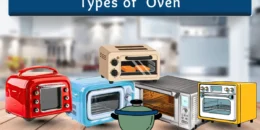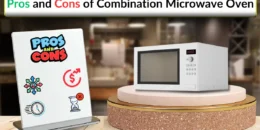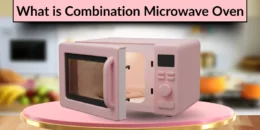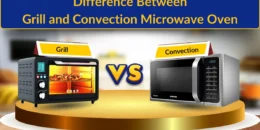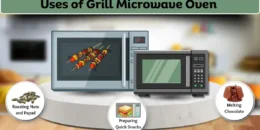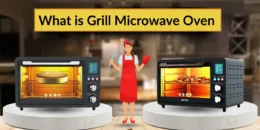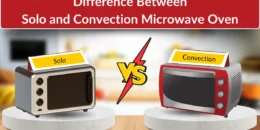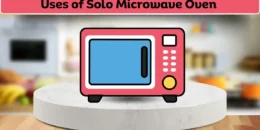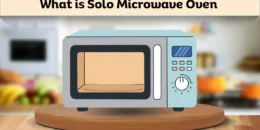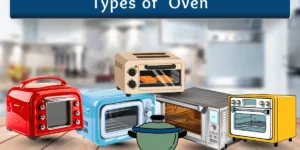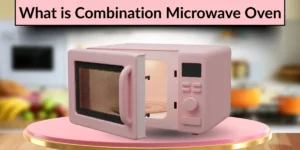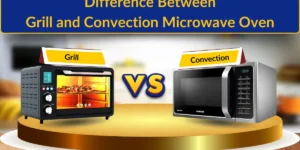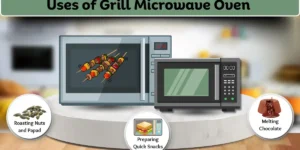Ever wondered if a convection oven is really worth it? Learn about different types of ovens and why convection models are popular for faster, evenly cooked meals. They use a built-in fan to move heat evenly around your food. But like any kitchen tool, they have both benefits and drawbacks. In this post, we’ll explore the key pros and cons of convection oven to help you make the right choice.
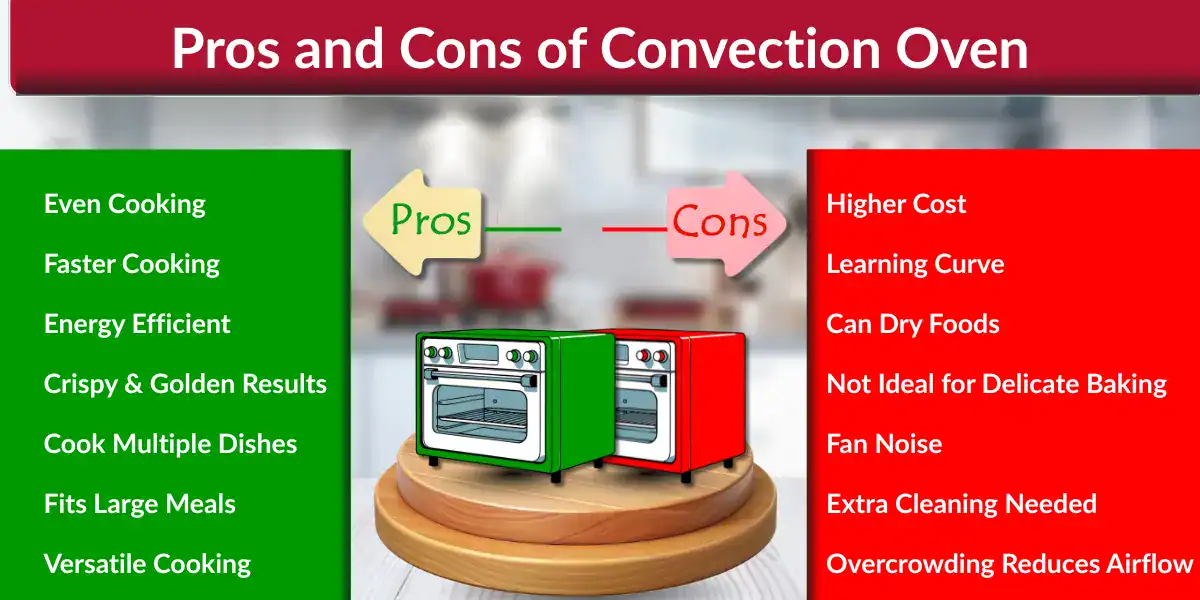
What Are the Pros and Cons of Convection Oven?
A convection oven cooks with hot air that moves around your food. This makes cooking faster and more even. But like any appliance, it has both good and bad sides. Some foods turn out perfectly crispy, while others may dry out. Let’s look at the real advantages and disadvantages of convection oven to see if it fits your kitchen style.
Pros of Convection Oven
A convection oven makes everyday cooking faster and easier. It gives food a crisp finish and saves energy at the same time. Here are the advantages of convection oven you’ll love:
- Even Cooking in Convection Ovens
- Faster Cooking Performance
- Energy-Efficient Cooking
- Crispy and Golden Results
- Cook Multiple Dishes at Once
- Fits Larger Meals Easily
- Versatile Cooking Options
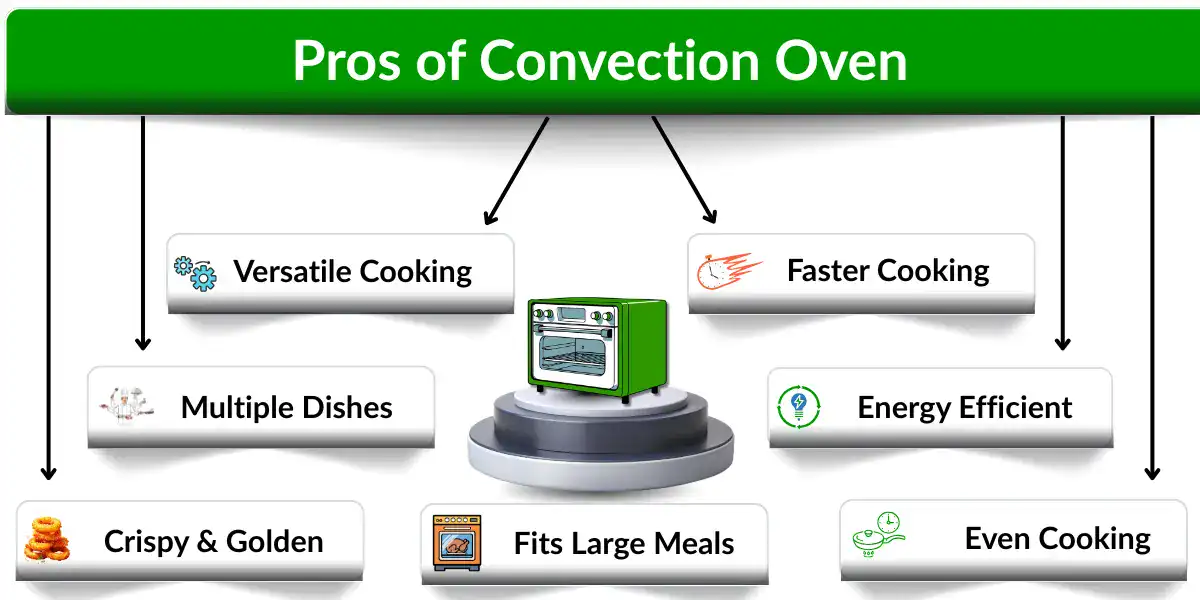
Let’s understand the above mentioned key benefits one by one.
1. Even Cooking in Convection Ovens
A convection oven cooks food evenly from all sides. The built-in fan spreads hot air around every corner, so no part stays undercooked or burns. Whether you bake cookies, roast chicken, or heat leftovers, everything cooks at the same pace. You don’t need to turn trays or swap racks because the heat stays balanced everywhere.
2. Faster Cooking Performance
A convection oven cooks food much faster than a regular oven. The fan keeps hot air moving, so heat reaches the food quickly and evenly. You can finish your meals in less time without losing taste or texture. It’s great for busy days when you want dinner ready fast but still perfectly cooked.
3. Energy-Efficient Cooking
A convection oven uses less energy because it cooks food faster and at a lower temperature. The steady airflow helps the oven reach the right heat quickly and hold it longer. This means you spend less time cooking and use less electricity overall.
4. Crispy and Golden Results
A convection oven gives your food a crisp and golden finish that many regular ovens can’t match. The hot air moves around the food, removing extra moisture and helping the surface brown evenly. It’s perfect for roasting chicken, baking fries, or toasting bread. Every dish comes out with a crunchy outside and a soft, juicy inside.
5. Cook Multiple Dishes at Once
A convection oven lets you cook more than one dish at the same time without mixing flavors. The fan spreads hot air evenly across all racks, so every tray cooks perfectly. You can bake cookies on one shelf and roast vegetables on another. It saves both time and energy, especially when cooking for a big family or party.
6. Fits Larger Meals Easily
A convection oven has a spacious interior that makes cooking big meals simple. You can roast a whole chicken or bake a large pizza without crowding the oven. The hot air moves evenly, so every part cooks perfectly. It’s a great choice for families who love hosting dinners or preparing large weekend meals.
7. Versatile Cooking Options
A convection oven lets you try many cooking styles in one appliance. You can bake cookies, roast vegetables, or reheat leftovers with the same oven. It also works great for toasting, broiling, and even dehydrating food. This flexibility makes it perfect for anyone who loves to experiment in the kitchen.
Cons of Convection Oven
While convection ovens offer many benefits, they also have a few downsides you should know. Understanding these disadvantages helps you cook smarter and avoid common mistakes.
- Higher Cost Than Regular Ovens
- Small Learning Curve
- May Dry Out Some Foods
- Not Ideal for Delicate Baking
- Fan Noise During Operation
- More Cleaning and Maintenance
- Overcrowding Affects Airflow

Let’s look at these disadvantages of convection oven in details.
1. Higher Cost Than Regular Ovens
Convection ovens usually cost more than regular ones because they include advanced features like fans and heating elements. This higher price can be a concern if you’re on a tight budget. However, the extra cost often pays off in the long run with faster cooking and better energy use.
2. Small Learning Curve
Cooking in a convection oven takes a little practice. You need to adjust temperature and time because food cooks faster than in a regular oven. At first, it might feel tricky, but once you understand how airflow and heat work, it becomes easy to use.
3. May Dry Out Some Foods
Convection ovens use a fan to circulate hot air, which cooks food faster. But this same airflow can make some dishes too dry. Foods like cakes, custards, or meat with low fat can lose moisture if cooked too long. To avoid this, reduce the cooking time or cover food lightly.
4. Not Ideal for Delicate Baking
Some baked goods don’t do well in a convection oven. Light and airy foods like soufflés, sponge cakes, and pastries can lose their shape because of the moving air. The fan can make them rise unevenly or dry out too fast. For delicate baking, a regular oven gives better, softer results. It keeps the texture light and even.
5. Fan Noise During Operation
The built-in fan in a convection oven makes a steady noise while it runs. For most people, it’s not too loud, but it can still be noticeable in a quiet kitchen. If you’re sensitive to sound, this might bother you at first. The good thing is, the noise usually fades into the background once you get used to it.
6. More Cleaning and Maintenance
Convection ovens need a little extra care to stay in good shape. The fan, vents, and interior collect grease faster than regular ovens. You may need to clean them more often to keep airflow smooth. Regular wiping and deep cleaning help your oven last longer and cook evenly every time.
7. Overcrowding Affects Airflow
When you pack too many dishes inside a convection oven, the air can’t move freely. This blocks the hot air from reaching every side of the food. As a result, some parts cook faster while others stay undercooked. To fix this, leave enough space between trays and dishes.
Should You Buy a Convection Oven?
A convection oven is great for people who cook often. It heats food evenly, cooks faster, and can make meals crispier. Busy families and home bakers will save time and energy. If you cook rarely or mostly reheat food, a regular oven may be enough.
Who benefits most:
- Home bakers roasting, baking, or making large meals
- Busy families cooking multiple dishes at once
- Professionals who want faster, even, and energy-efficient cooking
Who may not need it:
- Casual cooks who use the oven occasionally
- People who mostly reheat or warm food
- Bakers focused on delicate cakes or soufflés
Expert Advice:
If you cook often and value crispy, evenly cooked food with less energy waste, investing in a convection oven can improve your kitchen experience.
You may also Like these posts:
Types of Oven Explained with Uses & Benefits
Types of Microwave Ovens with Uses – Easy Guide for Home Cooking
Pros and Cons of Combination Microwave Ovens
Conclusion
So, guys, now let’s wrap this up. We’ve explored all the pros and cons of convection ovens in detail. These ovens cook faster, save energy, and give you crispy results. But they also need a little learning and care. If you love quick and even cooking, a convection oven is worth it. Try one and see the difference.
Did this guide help you? Share it with friends or leave a comment below!
FAQs about Pros and Cons of Convection Oven
Many people have questions before using a convection oven. Here are some simple answers to help you understand it better and cook with more confidence.
Is a convection oven worth buying for home use?
Yes, a convection oven is a good choice for most homes. It cooks food faster, saves energy, and gives a crisp, even finish. You can roast, bake, and reheat easily with one appliance. However, if you only heat food or cook occasionally, a basic oven may be enough. Think about how often you cook before buying.
What type of cooking is best suited for a convection oven?
A convection oven works best for roasting meats, baking cookies, and making crispy dishes. The fan circulates hot air evenly, so food browns perfectly. You can also reheat leftovers without losing texture. However, it’s not ideal for soft cakes or desserts that need gentle heat. Switch to bake mode for those recipes.
Do convection ovens use more electricity than regular ovens?
No, convection ovens are usually more energy-efficient. They cook faster and often at lower temperatures, which reduces power use. Even though they have a fan, the shorter cooking time balances energy costs. You’ll notice lower bills if you cook smartly. It’s a great option for frequent cooking.
Can convection ovens replace regular ovens completely?
For many recipes, yes, they can. You can bake, roast, and broil easily in a convection oven. It gives better results for crispy and evenly cooked meals. But for delicate cakes or slow-cooked dishes, a regular oven still performs better. So, it depends on your cooking style.
What are the common problems people face with convection ovens?
Some people find their food dries out or cooks too quickly at first. The fan can also make noise while running. Cleaning takes a bit more effort because of extra racks and vents. Once you learn the right settings, these issues go away. Proper maintenance keeps it running smoothly for years.
Are convection ovens hard to use for beginners?
Not really, they just take a little practice. You may need to lower the temperature or reduce the cooking time slightly. Most modern convection ovens come with preset modes for easy use. Once you try a few recipes, you’ll get comfortable quickly. It’s beginner-friendly and simple to handle.
How long does a convection oven usually last?
A good-quality convection oven can last around 8–10 years. Regular cleaning and proper use extend its life. Avoid blocking vents and overloading trays. If you take care of it, the performance stays strong for a long time. It’s a durable investment for your kitchen.
What is better, convection or traditional oven for baking?
It depends on what you bake. A convection oven gives better browning and faster results for cookies, pies, and roasted dishes. For soft cakes, muffins, or bread, a traditional oven works better. Some ovens even let you switch between both cooking modes. This flexibility helps you get perfect results every time.

